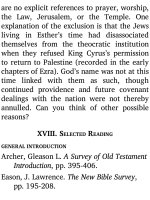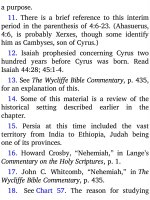Jensens survey of the old testament adam 266
Bạn đang xem bản rút gọn của tài liệu. Xem và tải ngay bản đầy đủ của tài liệu tại đây (118.36 KB, 4 trang )
times in each of the books of Haggai and
Zechariah.
IV. JEWISH LEADERS OF THE RESTORATION
Review this subject also as it
rst
appeared in chapter 15. Note these names
o n Chart 57: Zerubbabel, Ezra, Nehemiah,
Haggai, Zechariah, and Malachi. Observe on
the chart that most of Malachi’s ministry
took place during Nehemiah’s return visit to
Babylon. Those were years of backsliding on
the part of the Jews in Canaan, when the
rst spiritual zeal had subsided. Hence, the
message of Malachi was mainly about sin
and its judgment.
V.
RESTORATION FOR THE JEWS
AND THE WORLD
IMPORTANCE OF THE
The restoration was important for various
reasons. For Israel, it showed that God had
not forgotten His promise to Abraham
concerning the land of Canaan. (Read Gen
13:15 and note the strength of the word
“forever”.) Hence, the relocation of a
returning remnant. Hope for a missionary
outreach to Gentiles was stirred up in revival
of true worship, for a key mission of Israel
was to show heathen nations what true
worship of the true God was. And then, the
restoration was directly related to the life
and ministry of the coming Messiah, in the
renewal of the Messianic promises. For
example, Bethlehem, Nazareth, and Zion
were some of the geographical places woven
into the promises concerning Jesus’ coming.
In about four hundred years Jesus would be
born of the seed of David in Bethlehem, not
in Babylon. The Holy Land of promise, not a
land of captivity, was where His people
would be dwelling when He would come
unto them, “his own” (John 1:11).
VI. RESTORATION OF END TIMES
Israel’s restoration in the sixth and fth
centuries B.C. was but a mere shadow of the
nal restoration in the Messianic Kingdom
of the end times. This is the principle of
multiple ful llment studied earlier. Be ready
to apply the principle to the messages of the
postexilic prophets. For clear revelation that
Israel will play a prominent role in world
history of the end times, read Romans 11.
VII. THE MINISTRIES OF THE LAST THREE PROPHETS
S e e Chart 57 and note that Haggai and
Zechariah ministered around the beginning
of the restoration period, and Malachi
toward the end. In the pages that follow,
more will be said about the immediate
setting of the writing of each of their books.
This may be noted now: the main appeal of
Haggai and Zechariah was to inspire the
Jews to nish building the Temple which
had been discontinued in 534 B.C. (Chart 57),
and the burden of Malachi was the tragic
apostasy of God’s people. Whatever there
was of revival and spiritual restoration in
Israel’s return from exile had, by Malachi’s
time, degenerated to spiritual coldness with
threat of disaster. It is not without
signi cance that the last word of Malachi,
and therefore of our Old Testament, is the
awful word “curse” (Mai 4:6). What
thoughts come to you as you compare this
last verse with the Bible’s rst verse, Genesis
1:1?
HAGGAI: BUILD THE HOUSE, AND I WILL
BE GLORIFIED
Haggai is one of the shortest books of the
Bible, called by someone “a momentous
little fragment.” Among its prominent
teachings is the necessity of putting rst









